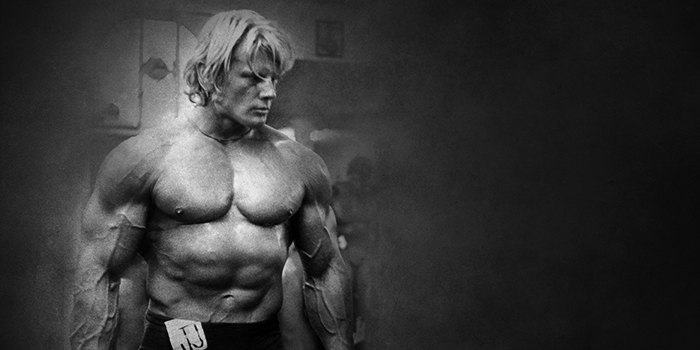
The first television set I remember us having was the kind of set that anyone reading this who grew up in the 1970s would vividly remember. It was a large piece of furniture resting upon four sturdy legs with a decorative golden strip of metal just above its feet. It was the centerpiece of the shag carpet living room. Big and bulky and sturdy enough that you could display other decorative items on top of it.
Sometime during its lifetime, the knob to this television had come off (whipping around the channels too fast, like your Mom and Dad told you not to do, would do the trick with these analog moving parts). So, to turn the channel, you used a set of needle-nose pliers to grab the metal nub remaining from the broken knob to turn the dial to any of the 13 or so channels you got. The bulky two-button remote was missing in action, and you personally don’t remember it ever working. So, whatever program was on, that is pretty much what you watched, cigarette commercials and all. For one, it was a pain to get up off the deep couch and walk over to the set and change the channel with the pliers, as they could never quite grip the nub, and the more you used them, the more the nub grew smooth and more challenging to turn. And two, with 13 channels and not all of them actually having content (some routinely featured television shows with a vertical hold issue), if you found a decent show, you stuck with it.
RECENT: Why the Smartphone is Your Greatest Advantage in Meet Training
Fast-forward a few years. The year was 1977-78, and I was in fifth or sixth grade. We had a new television. This one came with a working remote and sat legless and boxy in a wall-sized piece of furniture that was in vogue at that time. As I was sprawled out on the couch, the Incredible Hulk TV series appeared on the channel I happened to be watching. This show starred the famed Bill Bixby, who I remembered from the television program he had been in prior, The Courtship of Eddie’s Father (Google it). Also in the show, playing the Incredible Hulk was a young and powerfully built Lou Ferrigno, just a year or two out of his most recent Mr. Olympia contest. I recall watching the episode and enjoying the whole sci-fi aspect of it, as it appealed to my nerdy side, which continues to this day. However, when Bill’s character, David Banner, transformed into the Hulk and Lou stood there, suddenly, this became for me something far greater than a new television show playing on our new television set. Even though I now could click to the next channel plier free, I wouldn’t dare to do so, as I was transfixed by this program and by Lou.
I recall watching every episode after that, and instead of enjoying the sci-fi, Marvel aspect, I felt the plot was now a nuisance, as I just wanted to get through with the story and onto seeing Lou. He would appear toward the end of each episode, and he would go through this process of transformation, his metamorphosis from Banner to the Incredible Hulk. So, I was watching the entire program really just for the few minutes that Lou’s character was featured in his ultra-muscular self.
This was a moment of discovery for me, as this was my introduction to strength, power, muscle, and ultimately, the weight room. Because this was decades before you could Google anything, I began to look for information on this whole “How do you get strong and big like Lou did?” phenomenon I had stumbled upon.
I began to talk with some friends of mine about this show, about muscle and the like, and we discovered some old bodybuilding magazines. Also, one of the kids’ dads had an old weight set and some dumbbells in the corner of his basement. So, after school, we would go straight from our bus stop to our friend’s house, where the old weight set was and where we kept and studied these magazines. For me, this is when the doors to this whole world of muscle and power and strength, of which I was totally unaware, blew wide open.
There on the pages of these magazines were lifters like Lou, Dave Draper, Sergio, Arnold, Franco, Robbie Robinson, Frank Zane, and others from what we now call the golden era of bodybuilding. These were guys who were living a lifestyle I didn’t even know existed. They were training with weights, building strength and muscle, and it simply looked like the best life you could ever have.
Photo courtesy of Laree Draper
The months passed, and as their interest in lifting and muscle and strength diminished, so did the number of my friends who would meet up at our little space in the corner of my friend’s basement. That year, I found a gym, Drew’s Gym. Drew’s Gym is one of the many magical gyms that no longer exists except in memory. Drew’s Gym was owned by a guy that was built like one of my current powerlifting buddies, Big Steve Brock (although I have never shared that with Steve—until now).
Drew was a shorter, massively thick and powerful guy but whose size and power were juxtaposed against his calm demeanor. He was a deeply spiritual man, peaceful and reflective, and he found strength not just through his weights but through reading his Bible(s). I use the plural because he had loads of Bibles, and they could be found in several of Drew’s reading spots located all around the carpeted area of the gym. The carpeted area was this little section of the gym set back from the weight room area of the gym. The area was literally carpeted in a short shag-type carpet, and in that area was a well-worn La-Z-Boy recliner, an old couch, and a wooden coffee table covered with several of Drew’s Bibles (each one highlighted with a different colored highlighter) as well as piles of muscle magazines, like the original IronMan, Muscle Builder/Power, and the like.
The gym itself was in a very old building with very tall and ornate off-white ceilings. The main front wall of the building faced the street, which came directly off of the town’s square. This main wall where the entrance was located was all windows, floor to ceiling, and sunlight poured into the gym on sunny days. The surrounding walls were covered in a style of wood paneling. The floor was this old and actually quite luxurious hardwood floor with rectangularly cut pieces of carpet laid over it every so many feet where the various weight stations were. Clearly, the intent when this very old and distinguished building was constructed was for it to feature a grand showroom, never a gym. But there was something perfect about the contrast between the ornate sculpings throughout the ceiling and the 1960s- and 1970s-era barbells, plates, and dumbbells that made the place so perfectly unique for finding your way in the world of strength and power. Close to the carpeted area hosting the lounge, coffee table, and couch were two bench presses. Toward the middle of the gym were stationed a couple of squat stands, dumbbells, and pre-loaded straight bars, and the perimeter consisted of plate-loaded pulley machines of the era and the era before that. Looking back in my mind’s eye, I now realize that none of the equipment was new, but that is hardly something I was aware of at the time, as all of it was new and foreign to me.
To me, this was the best place in the world. A place where you would go after school and move weights up and down while not having the slightest clue as to whether you were doing it right. In hindsight, mostly bodybuilders trained at Drew’s Gym, so I did what most people did at a time when your strength and power sources were limited to magazines and the library: you read and studied the lifters as they trained. So, after I would do what I thought was a workout, I, too, would sit on the sweat-stained couch next to Drew, who was sitting on his sweat-stained La-Z-Boy recliner. There was Drew reading and highlighting his Bible, with me reading and highlighting the content of the muscle mags. He was reading about the apostles of the Bible, and I was reading about the apostles of the golden era of bodybuilding. I would sit, read, and highlight, all the while watching the contrast between how the muscular lifters in the gym worked out versus the guys who were making the same amount of noise but never got any bigger or strong(er). There was a US postman who trained there, and he was a Mr. America competitor. He was put together, muscular and powerful, so what I saw him do, I did. On the same training day schedule was this rail-thin guy. I looked at him and his lack of muscle and power and made a mental note not to do what he was doing. Seemed logical in the mind of a now sixth or seventh grader.
While reading the old magazines, I looked at the physiques of guys like Dave Draper, the Blonde Bomber (who is 76 years of age as of this article). I studied his photos and then read the magazines stated as his training. It was like you were reading about these lifters, like Draper, whom you would never meet, yet they were somehow teaching you from afar through the pages of these magazines.
The magazines talked about many aspects of the lifting lifestyle—for example, nutrition and training—and the photos were inspirational. Most days I would work out at Drew’s Gym, and some days I would lift in my parents’ garage. I would use my one piece of equipment, my barbell (the kind with the thin metal bar and two sand-filled plastic plates at the ends). I would do bicep curls and overhead presses while looking at my reflection in the convex side window of our 1972 Chevy Malibu. The convex nature of the glass was like a circus mirror, and depending on where you stood, it could make you look huge.
I vividly remember reading about health foods and how to make your own health shakes. My first shake comprised all of the ingredients I read about, all purchased individually at the local family-owned vitamin store (I still prefer a mom-and-pop-owned nutrition store like that versus the big corporate mega stores that sell supplements today). We had a heavy glass pitcher for the blender, and I set out all of the individual powdered ingredients to the side on the kitchen counter. One by one, I would put a tablespoon of each ingredient into the milk-filled blender. I had desiccated liver powder, wheat germ, brewer’s yeast, lecithin, oats, honey, a whole egg, peanut butter, and a banana. As vividly as I remember reading about health shakes, I also vividly remember that the first shake I made tasted like hell. I mean it was exquisitely horrid—but nothing that a spoonful of Nestle Quik and a scoop of ice cream added to the mixture couldn't fix.
With these as starting points for a lifetime with weights, the lifting continued throughout junior high school and high school. I worked with weights during wrestling season, during track season, and throughout the remainder of high school. It was in college where I discovered powerlifting. There was a world of difference from guessing at how to lift on your own to being formally introduced and coached by an experienced powerlifter about techniques, training programs, and virtually every facet of the sport in between. My first powerlifting meet was in 1989, and the meets continued, three to four meets per year, for a couple of very fulfilling decades. Quite often I traveled to compete, be it competing at meets close to home or at meets as far away as South Africa. The competing, the simple act of picking up the weights and putting them right back down but making sure that yours were always heavier, was deeply fulfilling. The moving of weights is a major part of me as it is a part of you, and my training continues to this day, each Saturday, Sunday, Monday, Wednesday, and Thursday.
If you’re like me, after going from a grade schooler in the 1970s to a master age lifter now in his 50s, you note often how life around you changes, as does the world around you. Both are in a constant state of evolution, or de-evolution, depending on how you want to look at it. What’s interesting is what doesn’t change but rather is a constant. One of these things constants is that precious time at the gym when the weight is in your hands, on your back, or over your chest. What doesn’t change is where you want to be in this non-symbiotic relationship you have with the barbells, dumbbells, plates, and weights. You want this relationship to allow for you to slowly but steadily move, inch by inch, pound by pound, toward constant self-improvement, be it in your strength, power, or muscularity.
A couple of years back, my brother, Kirk, and I were making several weekend trips to visit our mom, who was in the hospital. For a little more than 10 months, we would work during the week and then drive some seven hours to spend each weekend with her in the hospital as she clung to life, eventually clawing her way back to a full recovery. During those months, I considered removing myself from Team elitefts as a columnist. I was not sure I could find the focus or the time to write, and the last thing I wanted to do was let my fellow elitefts team members or Dave Tate down by not holding up my end of the bargain. Additionally, I was having trouble finding the focus required to move big weights, as my mind and energy were focused on my mom and on what she was going through. I remember speaking to Dave Tate about both of these concerns. Dave Tate shared that he had gone through something similar a couple of times. He shared his thoughts about my keeping my mind sharp during these very dark and worrisome days. How writing can be as much therapy as it could be an escape from worry, and how it could be a tool to keep your mind sharp while in the midst of such a life-altering event. Dave Tate said write when you can, keep your mind in the game, and don’t worry about deadlines. Dave Tate also shared his thoughts about how I could keep training. He talked about how being strong physically was the way to stay strong during the week, strong while driving seven hours each Friday and seven hours back home each Sunday, and how being physically strong served as a source of strength for my mom during each and every visit. The recipe for that was hypertrophy work, as you can go deep within yourself for many reps and sets and increase your size, maintain your health, and protect your central nervous system, which is easily compromised with heavy training. Having powerlifted for nearly three decades, all I knew about hypertrophy was what I had observed back at Drew’s Gym as a little kid, and that was clearly not going to cut it. So, just like when I looked at the old bodybuilding mags, read the books on lifting from the library, and studied the difference between the muscular guys versus the rail-thin ones back in the 1970s as a kid, I again found myself trying to obtain useful information about hypertrophy, this time online. As a kid, I could barely find this information, and now, there was too much of it. I spent a significant amount of time weeding through the information, as a majority of the information online was garbage. I found some of the most useful information right under my nose from the elitefts guys, like Dugdale and Meadows, and that was amazingly helpful. Then, one day when googling some more on hypertrophy, I stumbled upon a name I remembered from all of those years ago. I stumbled onto a blog of sorts, a newsletter from none other than Dave Draper — 1965 International Federation of BodyBuilding and Fitness Mr. America.
Photo courtesy of Laree Draper
It was a little surreal, as I was now considerably older than Dave Draper was back then when I had originally read about him in the late 1970s, all of those decades ago when I was with my grade school friends in the corner of a friend’s basement lifting weights and reading old muscle magazines. It was like re-discovering this amazing thing you once had but thought you had lost so many years ago, only to find that it was there all along. What a great happenstance and a great resource. Turns out that Dave Draper, now in his 70s, had a great deal of content out there. The difference was that his content wasn’t about the latest thing, the newest trend, or the best-kept secrets. In fact, his content was virtually the antithesis of this. Dave Draper’s content mirrored what Ernie Frantz used to tell me in the 1990s and what I share with the newer lifters at the Monster Garage Gym to this day. Dave Draper and Ernie Frantz talked about the secret: that there is no secret. That long and complex explanations are often created by those who overanalyze or who are trying to sell you something. Dave Draper’s blogs and books spoke about how the things that worked in the 1970s still work today. That the bedrock of success in the weight room is simply hard, hard work, consistency, intensity, good nutrition, a solid program, great form, rest, common sense, and a deep passion for what you are doing. So, I started “following” Dave Draper….for a second time, now some several decades later. I read about how these guys trained back some 50 years ago. How they developed strength and power and muscularity with plain and simple barbells and dumbbells. I say this because clearly all of the innovations in the weight room are not the difference maker or everyone coming out of Corporate Gym A through Z would be pulling 700 pounds and be built like Sergio Olivia was.
During the months that my mom was in the hospital, through her full recovery, and through today, I have found great value in reps and sets as a means to an end. When my mom was sick, that end was seeing her through health-wise and maintaining and improving my training at the same time. Reading Dave Draper’s question-and-answer content, then his blogs, and then his books, I kept finding this same theme in his writing: how lifting can be applied to all aspects of your life. I found this all to be true, as the weights have always been there for me.
Now, long gone are the days of making my own horrid-tasting healthy shakes. I instead do a rotation of manufactured protein shakes. One day it is an egg protein, and the next day it is a casein protein, both by Universal Nutrition. The third day I take a mix of a whey and casein protein from none other than Dave Draper. The rotation of the proteins keeps food allergies at bay, but that is a story for another time. I discovered Dave Draper’s protein, as it was almost buried within his Web page. Clearly, his emphasis is on the content of his message, and his protein is almost like an afterthought. It is like, “Oh yeah, by the way, I’ve got protein and books for sale, too.” Kind of reminds me of Dave Tate. There is a ton, and I mean a ton, of content at elitefts, and “Oh yeah, we sell lifting stuff, too.”
So, for a good while, this was routine. Train, maintain a good bead on my mom’s health, work, family time, Monster Garage Gym time, coach powerlifting, eat, sleep, learn, rotate proteins, follow the Daves (Draper and Tate), keep in contact with Ernie Frantz, repeat.
Then, I got an email.
The email was from Laree Draper. Laree Draper is Dave’s wife, and she was sending a bulk email to all of the buyers of Dave Draper’s Bomber Blend protein powder. The long and short of it was that she and Dave were going to call it a day after a 20-year run selling his unique protein blend (whey and casein). They were going to discontinue making the Bomber Blend protein. With shipping prices going up nationally, Amazon Prime providing free shipping and the manufacturers wanting more sales, it was the perfect storm as well as an appropriate time to call it a (20-year) day. Even as they were pondering this final decision, other companies were wanting to put Dave Draper’s likeness on their existing proteins, not his specific ingredients. This was not an option they were going to consider. What? Ethics and morals in the industry portion of strength, power, and muscles? With the Drapers, yes. Knowing that he could have gone on and sold a compromised product, he designed only served to affirm the collection of words that Dave Draper had carefully sewn into the stories, lessons, and perspectives contained in the books he had written. Books written from the perspective of one who had spent a half-century with iron in his hands.
Anyway, with the pending cessation of the protein portion of Dave Draper’s online business, I found myself reflecting on how it must feel to have something that was created with a lifetime of knowledge—something that had rested on a solid bed of morals and ethics—only to have to end it due to business factors totally separate and irrelevant from the glorious intent of sharing the love of strength and power with others. Also, in some strange way, I was feeling as though I had discovered the inspirational Dave Draper decades ago when I was a kid and then re-discovered him as an adult through his online content and books, so the termination of his product, albeit by his own iron-wielding hands, felt strangely like a little loss yet again. After a few days of reflection, I emailed Laree Draper just to share how I felt about Dave Draper, his protein, his amazing books, and his inspiring life with the weights. In all honesty, my email to Laree Draper was really more for my sake than anything else, as although he had been a presence in my timeline of lifting. To him, I am one of the thousands of unknown lifters who supplements meals with his protein and reads his books and content as a way to better my training and gym experiences. Anyway, I typed some words onto the screen and hit send. I am sure, like so many others who used his protein powder, that I purchased a few extra canisters knowing from Laree Draper’s email that these final orders were coming from the last batch ever made. So, with a few extra tubs of his protein powder on my shelf, I went back to my routine: train, maintain a good bead on my mom’s health, work, family time, Monster Garage Gym time, coach powerlifting, eat, sleep, learn, rotate proteins, follow the Daves (Draper and Tate), keep in contact with Ernie Frantz, repeat.
A day or so later, I got an email. It was from Laree. She had received my email and shared its contents with Dave. She also indicated that she and Dave had owned a gym for some 15 years and wanted to support mine (Monster Garage Gym). They sent to the gym one of their fabricated gym pieces, the Top Squat (similar to the handles of the safety squat bar that you would see at elitefts). I felt completely honored that the powerlifters in my gym would be using this gift from Laree and Dave Draper, and I was now fighting a losing battle not to come across like a “fanboy.” But then, an email from Dave Draper himself came across my screen.
Photo courtesy of Laree Draper
In it, he talked about the Bomber Blend, mentioned the Top Squat, and took the time to thank me for the “kind words” of mine, which he quickly downplayed with, “If only I was half the person you describe….”The saying goes, don’t meet those you have looked up to, as they will inevitably disappoint you. I can assure you that reading Dave Draper’s email—even though it was merely an email—was the antithesis of disappointment. I emailed Dave Draper back as the elitefts columnist in me was screaming in my ear, “You are corresponding with ‘the’ Dave Draper; ask the man some questions!” I wrote Dave and stated, “Perhaps one day, should you ever feel the urge, I could interview you by emailing you questions for you to answer also in email form. As an amazing writer that would capture your thoughts the best.” Dave Draper emailed back, and in his poetic style of writing, he kindly turned down my offer. Then, just below his closing salutation was a trio of dots and the words, “I’ve got an idea; send me one question, and we’ll see how it goes….” So, now I have bodybuilding legend Dave Draper willing to answer my single question. What will my single question be? How do I limit to a single question what I want to know from a man who has not only seen but also lived through the evolution of bodybuilding and weight training and is, in fact, one of the founding fathers? What do I ask a man who built a physique back in 1965 and if he walked into any contemporary gym today in his Mr. America condition, every lifter in the place would stop to behold a build somehow created with nothing fancier than barbells, dumbbells, steak, eggs, and elbow grease?
I took a couple of days to ponder my question, and this is the question I posed to him: “Of all of the lessons you have learned over your entire lifetime about lifting, what is the most important lesson that you have learned; likewise, of all of the lessons you have learned over your entire lifetime about life itself, what is the most important lesson that you have learned?” Prior to finally hitting the send button, I found myself re-writing the question, which was really two questions, over and again, hoping he would answer both. I was hoping for both to be answered; if you have read his books (which I highly recommend) and are a lifelong lifter, you would understand why.
When you read Dave Draper’s writing, you notice right away that his writing style is part lifter, part historian, part philosopher, and part poet, so I was fully expecting to read an answer that was equal parts lengthy and esoteric. To the contrary, the answer I received was succinct yet all-encompassing, two things that are amazingly difficult to marry. Dave Draper’s perfect answer was as follows:
“The answer has something to do with the daunting struggle confronting the determined lifter who does not have the natural qualities to achieve a strong, shapely, and muscular physique.”
As I read and re-read his words over again, I found them to ring so loud and so true. After all, the journey you are on as a lifelong lifter is just that—a journey. There is no destination, merely stops along the way. Lifting, be it powerlifting, strongman, or bodybuilding, is absolutely, purely, and at its core about the struggle. The very thing a person tends to curse or even avoid is the very thing that makes the journey worthy of a lifetime of pursuit. It is the daunting struggle confronting the determined lifter that makes the little victories along the way so wondrous. It is the daunting struggle confronting the determined lifter that keeps us humble. It is the daunting struggle confronting the determined lifter that prepares for the unforeseen and unavoidable challenges that lurk ahead on our paths. It is the daunting struggle confronting the determined lifter that forces us to grow as athletes, as lifters, as part of this thing called humanity. It is the daunting struggle confronting the determined lifter that helps us to, brick by brick, rep by rep, set by set, work toward becoming better versions of ourselves and to lift up others along the way. The daunting struggle comes in different shades and textures. The struggle can be as benign as simply finding your way through a strength sport, or the struggle to balance work, family, spirituality, and the gym in such a way that none are compromised and all are fulfilled. The struggle can be as challenging as decades of intense training, competing, and recovering from inevitable injuries that often require surgical solutions. The struggle can be as monumental as training around or through life-changing illness or the loss of a loved one. The daunting struggle gives our time in the gym meaning, and it is the thing we rise to overcome, as this is a universal measurement. “If it were easy, everyone would aspire to greatness” is far too cliche` of an explanation, and it was created for those who have never embraced or perhaps endured true struggle. But for those who have, who truly have, they know that these words absolutely capture the essence of a lifetime, a lifetime with iron in your hands.
Embrace the daunting struggle that confronts you, you, the determined lifter. You’re a lifter who perhaps does not have the natural qualities to achieve your own personal greatness, but you realize that it is how you fight to surmount the insurmountable that defines you.
Ever onward.










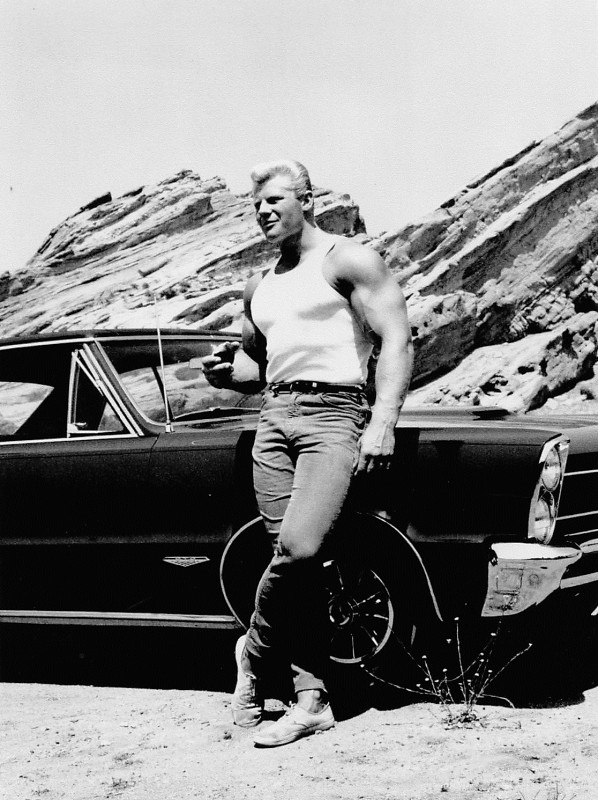
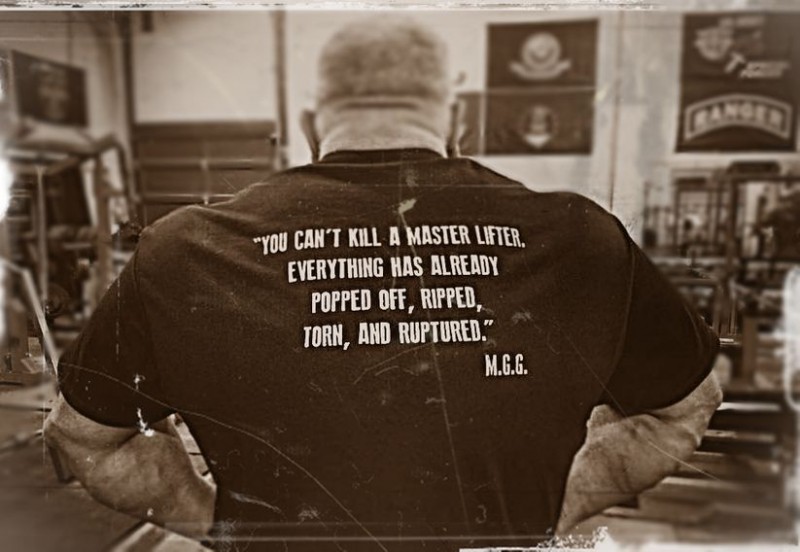
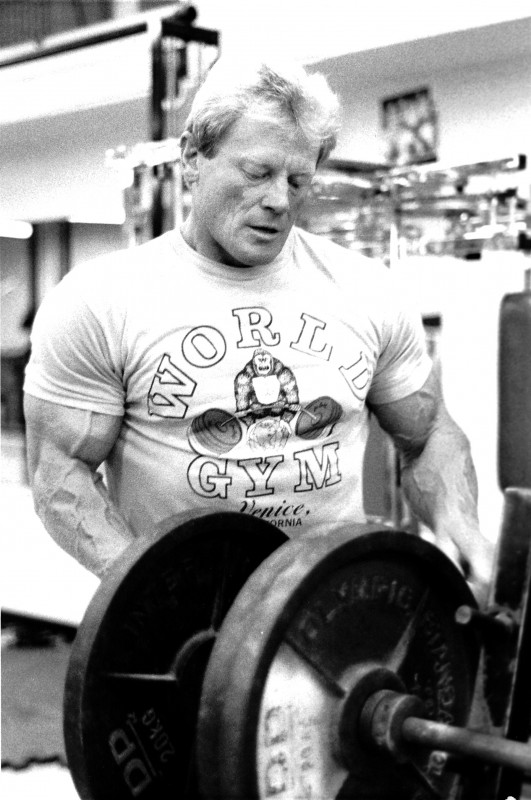
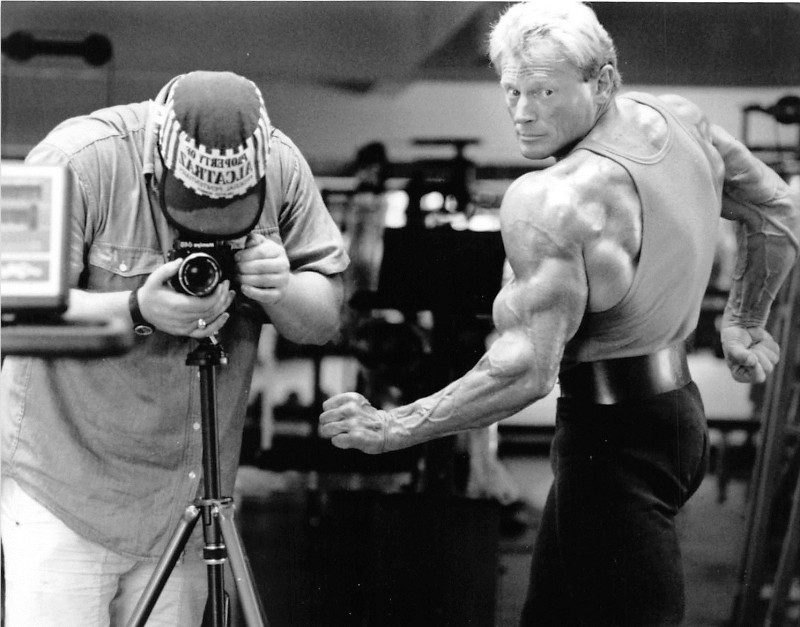
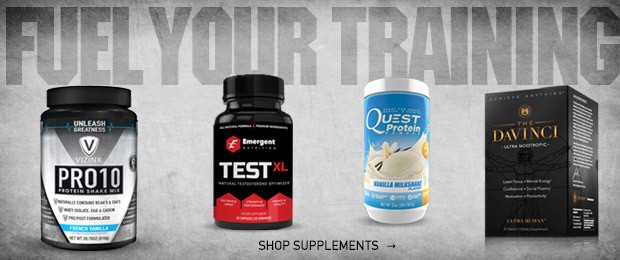
Perseverance!
God bless you , Ernie, Kaz, Dave, Lou, Arnold and all the greats of the golden era. Sure was a fun time to grow up wasnt it?
Congratulations, Phil. You did a great job. No fat within 10 miles of
your body and the muscle shape is reminiscent of the era you love.
Bill's a great guy and we were taping a portion of an interview and
conversation to be on DVD in about a month. Laree, my wife, is amid
the slow editing process. We compare notes in a QnA forum. You might
like it. Look for it on davedraper.com.
Great guy for sure !!
Good work girl.
Dan Z
Whenever I question — doubt my path as a life-long philosliftet, I think about Dave, show up at the squat rack, chase with some casein, and get cozy with being me, if only for an hour...
Amazing article about an inspiring guy.
One of my favorite quotes comes from the Blonde Bomber:
"All I want to do is lift weights and be happy."
Sums it up.
Vinceri vel Mori
Called excaliper and he nodded at me and said "good machine". A
Significant highlight. I bought extra bomber blend too. I like
His philosophy, paraphrasing "everything is better, lighter after visit to gym". Bob